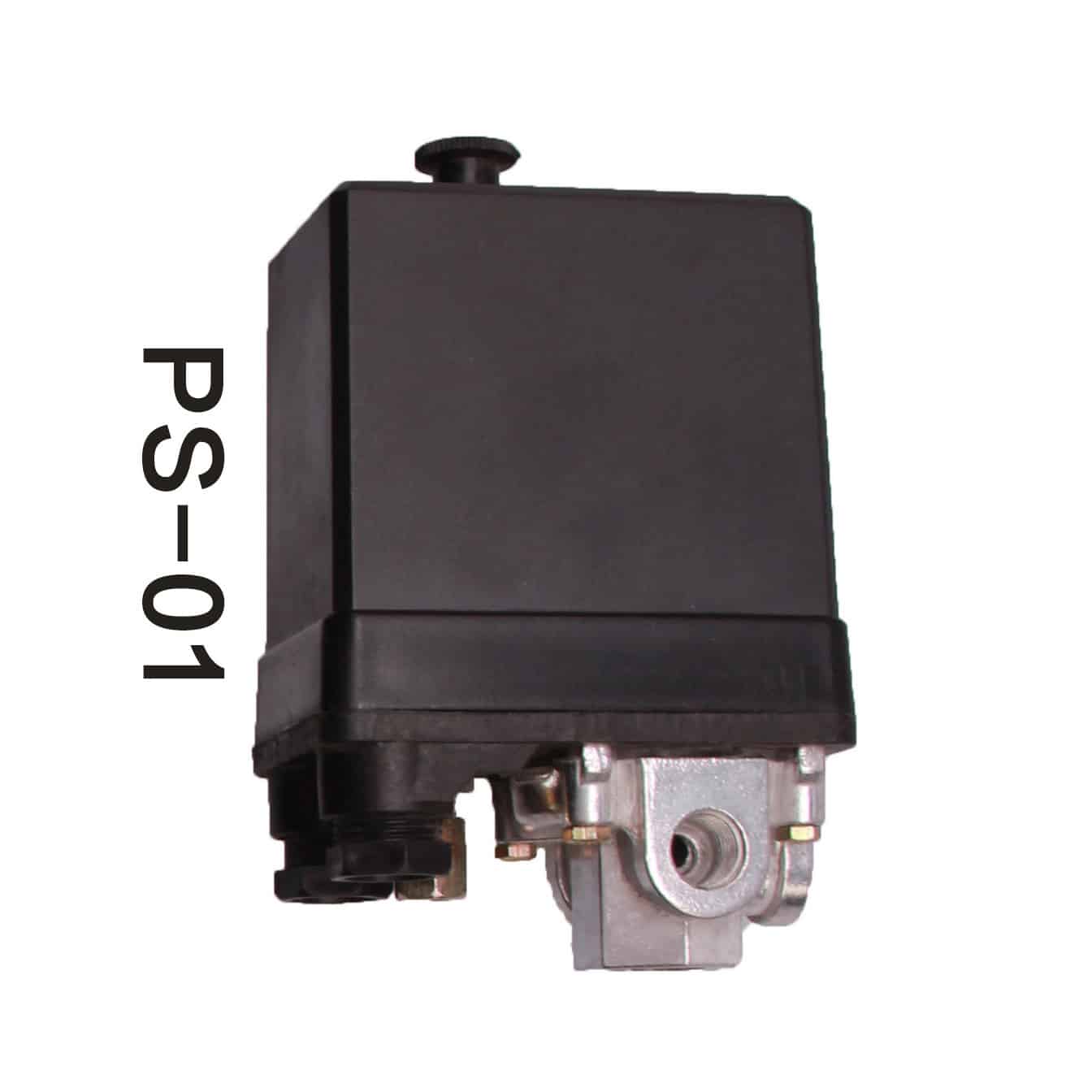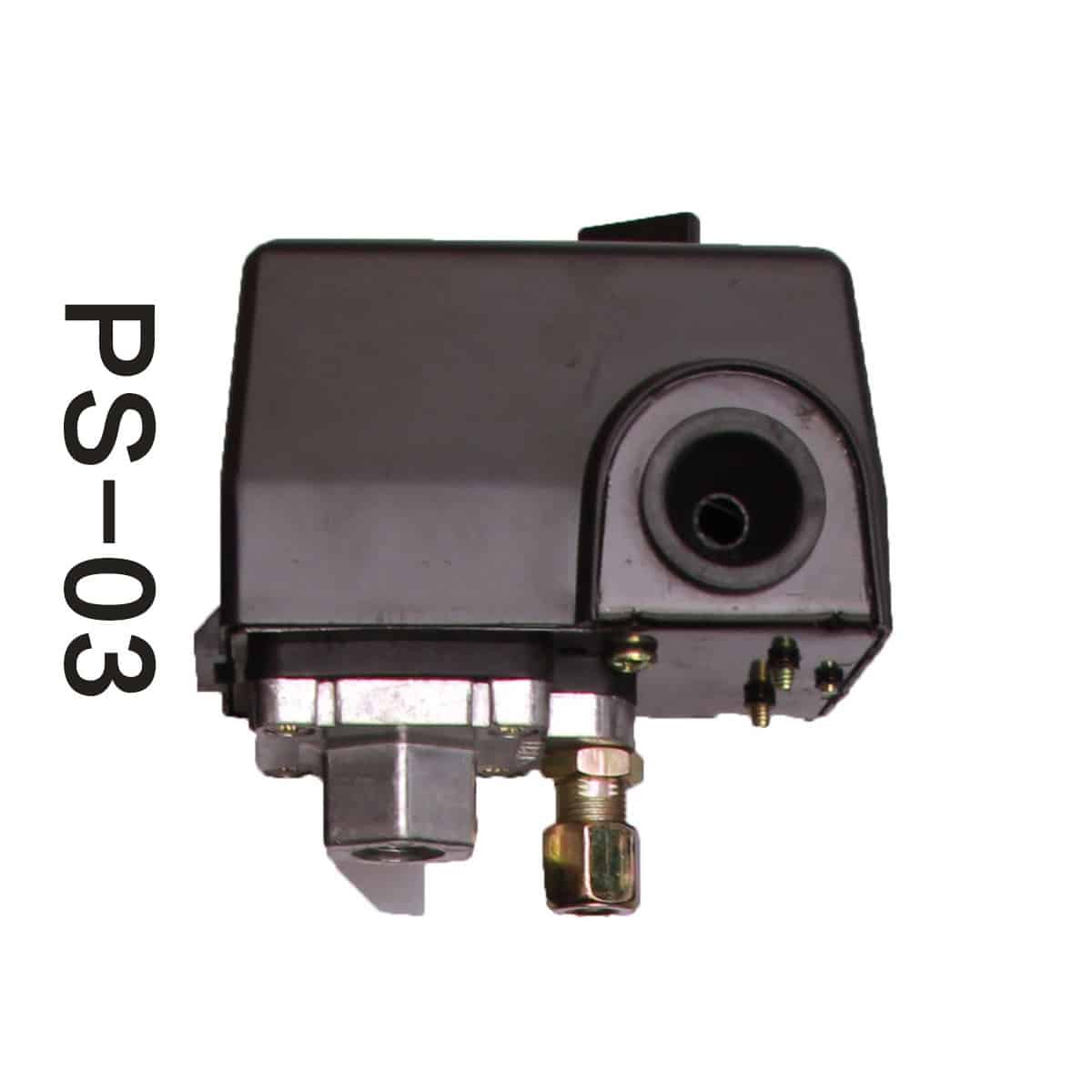China Air compressor pressure switch just for you
purchase Air compressor pressure switch for all models.
This product belongs to the BISON air compressor pressure switch series, which is an air compressor switch product. The air compressor switch has two normally closed, snap action, DPST-DB (double pole single throw, double break) style YY contacts and closes at a 125 PSI pressure set point.
contact us and Start Air compressor pressure switch business
Air compressor pressure switch manufacturer & supplier
There are many different types of air compressor pressure switch. So you need a compressor pressure regulator but are overwhelmed by various types, sizes and specifications.
Don’t worry! Let us help you.

Design
Bison Air compressor pressure switch has screw clamp terminals for electrical connections and 0.25″ NPSF internals for fluid connections. This low HP switch has a diaphragm actuator that can be operated from any position and a fixed differential scale for internal settings.
high-quality materials
Housing is made of polypropylene. It measures 2.78″(W) x 3.76″(D) x 3.71″(H) and weighs 1 lb. It is suitable for pressure control or monitoring pumps, compressors, agricultural/irrigation water systems, compression molding machines, injection molding machines, grinding machines, machining centers, complex and special purpose machines.
certificates
It is an IP20 and NEMA 1-rated product. This product is CE, CSA and UL listed. Meets UL 508 standards. Each pressure switch has two operating points, one for rising pressure and one for falling pressure. The operating point at which the pressure rises is called the trip point or cut-off point for pumps and compressors.
Get our best air compressor pressure Switch right now >>
If you have any enquiries about the BISON air compressor pressure switch, we would love to hear from you.

State-of-the-Art
Air compressor pressure switch
There is no better air compressor pressure switch than BISON. We have assembled a dedicated team of experts to develop cutting-edge pressure switch solutions. Over the years, they have innovated in pressure switch types and designs, processes and materials to provide you with best-in-class accuracy, reliability and service life.
Our air compressor pressure switches are made with high-quality materials and components, and they are built to last. We offer a wide variety of pressure switches to choose from, so you can find the perfect one for your needs. We also offer a variety of features and options, so you can customize your pressure switch to meet your specific requirements.
- Power pressure switches rated for direct control of motors in compressor applications.
- Rugged construction provides long life and years of uninterrupted, hassle-free service.
- Electromechanical switches for monitoring and controlling pressure conditions in industrial and end-user applications.
A detailed guide for beginners to advanced customers
What is an air compressor pressure switch?
The air pressure switch is a mechanical device that relies on pressure to control the operation of the electric air compressor. The pneumatic circuit mechanism of the device provides power for the motor to function. The air compressor pressure switch has a pressure switch relief valve.
This valve helps the machine start easier without the hassle of relieving head and line pressure. There are different air pressure switches available, each with other operating characteristics. However, the essential operation of the switch is the same for all devices.
After plugging in the air compressor, the person in charge can move the level to the automatic position. Due to this action, the motor is started, and simultaneously, the compressor is pressurized. As a result, a pressure system is reached in the device.
Due to this pressure setting, the diaphragm inside stops the motor by opening the circuit. At the same time, the back pressure escapes through the relief valve. As air is used, the pressure drops to the specified level. Also, once the contacts are closed, the motor starts. This process continues until the air compressor is put into use.
How does an air compressor pressure switch actually work?
Air compressor pressure switches use the airline to monitor the flow of pressurized air to and from the air tank. All pressure switches have an element that responds when pressure is applied. The most common device is the diaphragm, which deforms or compresses when exposed to pressurized air.
The air pressure in the compressor tank builds up, eventually creating enough back pressure (cutout pressure) to change the diaphragm’s shape. Deformation here will cause the pressure switch to move.
When the diaphragm of your air compressor pressure switch deforms enough, its movement opens the contacts inside the switch, which stops power flow to the compressor’s motor circuit, which prevents the compressor from further pressurizing the air in the tank.
A constant air pressure of a specific volume keeps the diaphragm deformed. When the air pressure in the tank drops enough, the membrane will return to its standard shape. Once this pressure (called cut-in pressure) is relieved to a certain level, the inner operator in the diaphragm deforms in the opposite way. This movement ultimately closes the circuit and starts the motor again.
Your air compressor pressure switch will continue this dance if your machine uses compressed air. The loop breaks when the device is no longer powered externally or has a problem. Any little leak from the compressor pressure switch and nearby casing can stop your important work and cause significant problems.
Components of the pressure switch
While there are several different designs for air compressor switches, a typical switch has six components:
a) Terminals
The pressure switch makes or breaks the circuit, which tells the air compressor when to turn on. The incoming and outgoing wires are connected or attached to the pressure switch through terminals.
b) Contacts
Contacts are two points in a pressure switch that combine to make or break a circuit. They are made of conductive metal, and when the contacts separate and the circuit is interrupted, the air compressor’s motor will shut off.
c) Diaphragm
A diaphragm is a flexible material that moves when the pressure inside the tank changes. As the pressure increases, the air pushes against this membrane. When the required pressure is reached, it pulls the conductive contacts apart, breaking the circuit.
d) Pressure switch relief valve
This relief valve is designed to relieve the pressure between the pump and the check valve. It can easily be found on the base of the pressure switch control, which is connected to the check valve by nylon or copper tubing. When the contacts separate, the valve is activated.
e) Adjustment springs
The cut-in point and cutout point of the air compressor can be adjusted with a spring. As you tighten the spring, more pressure must be applied from the diaphragm before the spring forces the contacts apart. When you let go of the spring, it moves with less pressure.
f) Auto/On/Off Lever
Some pressure valves have an On/Off knob, Auto/Off or lever to control the pressure switch. When it’s in the “auto” or “on” setting, it will work with the established cut-in and cut out settings to determine when the motor turns on and off. A plastic wedge between the contacts keeps the engine off when it’s off.
How to properly adjust the air compressor pressure switch?
The air compressor pressure switch adjustment is always inside the cover. Sometimes, you don’t have instructions, so following the instructions below will do the trick.
The primary adjustment instruction is turning the mainspring clockwise to increase or decrease the in or out setting. The pressure differential in an air compressor can be increased or decreased.
How to test the air compressor pressure switch?
Testing an air pressure switch involves the following steps.
- The first task in testing a pressure switch is disconnecting the power. You can disconnect it by unplugging the circuit breaker.
- Use a screwdriver to remove the switch cover. Try removing the task’s center screw.
- The blue or brown wire from the switch to the junction box must be cut. However, the black and white wires used for power purposes should not be cut.
- The next step is applying pressure to the switch using a pressure-generating source.
- The next step is to attach the ohmmeter that leads to the loose wires. Close the switch during air application. The ohmmeter shows zero ohms after the switch is closed, indicating good air pressure.
- Finally, adjust the pressure switch with the set point screw.
frequently asked questions about Air compressor pressure switch
What pressure switch is used on an air compressor?
The pressure switch setting a standard for many air compressors is set to 40 to 250 PSI with an adjustable differential pressure of 35 to 60 PSI. This means the lowest pressure the switch can be set to close is 40 PSI, and the upper highest pressure it can be set to open is 250 PSI.
What is the principle of a pressure switch?
A pressure switch is a passive device because all it needs to function is the presence or absence of pressure. Diaphragm pressure compresses the calibration spring. If the spring tension reaches or exceeds the set point, it closes a contact in a NO switch or opens a contact in an NC switch.
What is the pressure on the pressure switch?
Standard settings are 30/50 or 40/60. If you are a homeowner, whether to set the pressure switch at 30/50 or 40/60 is a matter of personal preference. It would help to consider whether you are comfortable with the water pressure in different areas of your home.
What causes a pressure switch to fail?
Typically, pressure switches fail because the diaphragm inside the housing is stuck or ruptured. A ruptured diaphragm sometimes makes a flapping sound. A stuck diaphragm will not move on the desired draft.
What is the difference between a flow switch and a pressure switch?
The flow switch monitors the flow rate of the medium flowing through the process pipeline, and the pressure switch monitors the pressure in the pipeline, pipe, or container.
What pressure should my air compressor be set at?
It depends on your equipment, so there is no optimal pressure. However, each additional bar/psi comes at a high energy cost. The goal is to reduce stress as much as possible without affecting the end user. This also means that the pressure drop from the compressor to the machine must be as low as possible.







